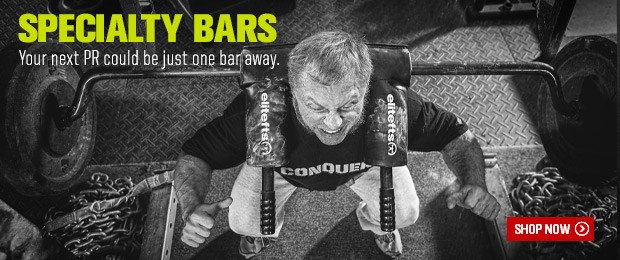
In a hurry for those next five pounds? It is no secret that we are all in a hurry. In the conjugate system, using builders is part of the solution. I have put together a short list of exercises I have used to build each of my lifts. There is no magic in these exercises without hard work. Give these exercises a chance over two cycles and then retest for your next record.
Special Exercises for the Bench Press
Illegal Wide Bench Press
Before specialty bars, illegal wide benching was one of the few options lifters had. It is much more than just benching with a wider grip. Illegal wide benching helps reinforce the habit of breaking the bar apart, pressing yourself away from the bar, and keeping the shoulder blades pinched down and back. This grip puts you at a disadvantage. Unless you are very wide, it will eliminate much of the lats for most lifters.
WATCH: Equipment Feature with Steve Diel — elitefts 3x3 Rack
We use it almost exclusively for max effort deload weeks. We start with a hard six on our first deload and add two reps each deload. After we get to a hard twelve we will cycle back to six and try to break that record by five pounds. It doesn’t always happen, and if it doesn’t we can look at it just like every other exercise and figure out what we need to work on.
I have long enough arms to use a grip half an inch outside the power rings. For those of you with shorter arms, it may be half an inch to a full inch outside your max grip width. You will perform this like a normal bench press. Lower the bar in a straight line and when you press the bar, spread the bar apart and press out with the triceps. Keep the reps in the six to 12 range.
Weight Releasers
- Category: Dynamic Effort Pairing/Precursor
- Reps: 3-6 singles, pre-set
I started using weight releasers 15 years ago. Like most, mine ended up in storage covered in dust a few years later. When I opened my gym I brought them out of storage. Since then I have included them in training for every level of lifter. The releasers can increase post activation potentiation, confidence, and teach lifters to lower heavy weights fast. The final benefit is that we can put a heavy weight in our hands a second day during the week without over-training. There is quite a bit of science that needs to be figured out yet. What we do know is that every lifter in my gym that has used weight releasers has benefitted from them. I have a basic cycle laid out in my article on bench training with trashy triceps. Since that article, we have used the weight releasers in three-week waves using a total combination of 95%, 100% and 105% of your max. If you feel that at any point you need more weight at your chest, you can lower the weight releaser by 5% and add 5% to the bar weight.
Bar Weight Cycle (95%, 100%, 105%)
- Week 1: Weight Releaser 30%, Bar Weight 65%
- Week 2: Weight Releaser 30%, Bar Weight 70%
- Week 3: Weight Releaser 30%, Bar Weight 75%
Band Cycle (100%, 105%, 110%) Band tension measured at lockout.
- Week 1: Weight Releaser 30%, Bar Weight 45%, Band Tension 25%
- Week 2: Weight Releaser 30%, Bar Weight 50%, Band Tension 25%
- Week 3: Weight Releaser 30%, Bar Weight 55%, Band Tension 25%
Only three singles with weight releasers are to be completed. Each single will be before three dynamic effort sets. Rest two minutes after each weight releaser single. Perform with this setup:
- Weight Releaser: 1 x 1
- Rest: Two minutes
- Dynamic Effort: 3 x 3 (30-45 seconds rest)
- Repeat three times
Change your grip after each round. Start with a close grip and work your way out.
The McDonald Bar (Cambered Bench Bar)
The McDonald bar has gone the way of the dinosaur. It disappeared only to be seen like Sasquatch marching through the woods. You might've found a cambered bench bar in a gym and not even known its intended purpose. We had one in college and we only used it for shrugs. This bar is great for adding time under tension by pressing from a deficit.
Cambered bench bars are great for max effort or multiple reps. Most lifters will want to bench to a one-board or two-board. All the way to the chest should be reserved for those who feel that they have the shoulders to handle it. Another use is to turn the bar upside down. It will teach you not to dump the bar, to keep your lats tight, and can allow you to put the bar in a spot where most people need extra work (but that is different from what I am talking about here).
Just because this bar has all but disappeared doesn’t mean you can’t find another alternative. The elitefts American Cambered Grip Bar has provided a great alternative. The change in handles, coupled with the camber, will build your press with less of a beating on the shoulders. This would be my first choice for a pressing specialty bar when building a home gym.
Special Exercises for the Squat
Good Morning Squats
These are difficult and humbling and that is why you should be doing them. It doesn’t matter if you free squat, box squat, use a specialty bar, or use a straight bar. You can’t be sloppy with these. The 40% to 60% range seems to work well in the six to 12 rep range. This is not a show-off exercise. It is a true builder. Do these very controlled. Round, squat down, and re-arch while tightening the lats. Come straight up without rocking on the box. This exercise will hit the hamstrings, upper back, low back and quads. The elitefts SS Yoke Bar and the rackable cambered bar both work very well with this exercise.
Special Exercises for the Deadlift
Ultra-Wide Sumo Deadlifts
If you are looking to bring up your leg drive and hip strength for your deadlift then this is for you. If your hip mobility is not up to par I would avoid this. If you have bad knees this might also be another exercise to avoid. But if you can handle the width, your hips will improve quickly.
Put thick collars on the inside of the plates, pushing the plates out further so you don’t smash your toes. Move your feet out near the plates or as wide as you can while keeping a good position. If your knees collapse in then it might take some mobility work, and you will need to move your feet out over a few weeks. After pulling yourself into an upright position, drive the feet out to the sides by spreading the floor apart. The goal is to use your hips and legs to lift the bar. A few heavy sets of three to five reps will be plenty.
Isometrics
Isometrics are great for increasing your time under tension at your stalling point. This isn’t so much a builder, but this is my article so I am going to include it anyway. We have seen huge improvements in our deadlift numbers after using isometrics in our meet prep. Four to six pulls against pins for six seconds will have you hurting. Run each isometric cycle for two weeks at a time. I have already outlined the full training cycle in a previous article, so I will leave it at that.
If your main movements have hit a wall, give these movements a try. Invest six to eight weeks and retest before changing any other variables. If you choose wisely, your max effort exercises will begin to move again and all will be right with the world.










